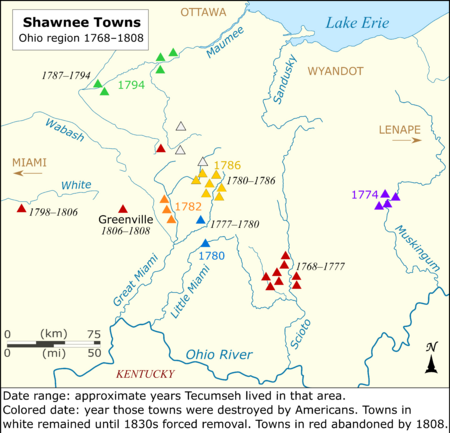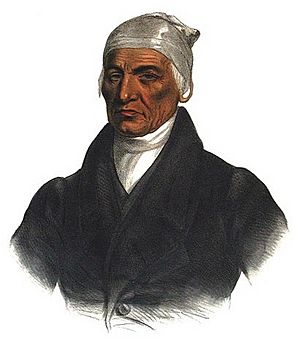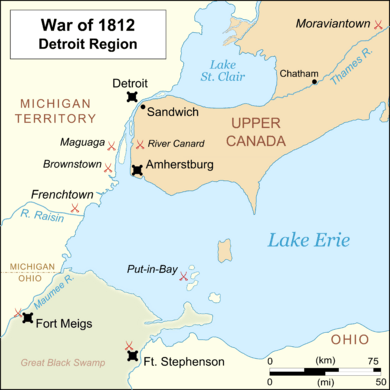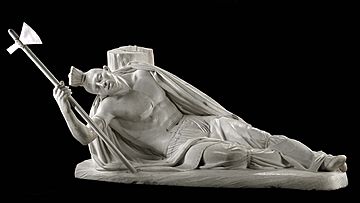Tecumseh facts for kids
Quick facts for kids
Tecumseh
|
|
|---|---|
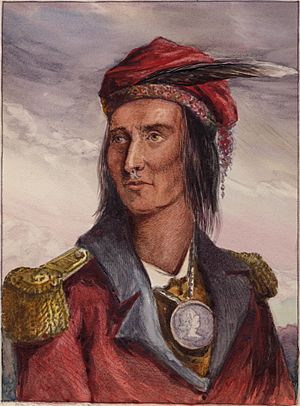
Painting of Tecumseh based on an 1808 sketch
|
|
| Born | c. 1768 Likely near present-day Xenia, Ohio, U.S.
|
| Died | October 5, 1813 (aged about 45) |
| Cause of death | Killed in the Battle of the Thames |
| Nationality | Shawnee |
| Known for | Organizing Native American resistance to U.S. expansion |
| Relatives |
|
Tecumseh (pronounced tih-KUM-suh; born around 1768 – died October 5, 1813) was a Shawnee chief and warrior. He worked to stop the United States from taking more Native American lands. Tecumseh was a great speaker. He traveled widely to create a Native American alliance and encourage tribes to unite. Even though his efforts ended when he died in the War of 1812, he became a famous folk hero in American, Indigenous, and Canadian history.
Tecumseh was born in what is now Ohio. At that time, many Shawnees were returning to their homeland in the Ohio Country. As Tecumseh grew up, the Shawnees lost land to the growing American colonies in many conflicts. His father was killed in a battle against American colonists in 1774. Later, Tecumseh was guided by his older brother Cheeseekau, a well-known war chief who died fighting Americans in 1792. As a young leader, Tecumseh joined Shawnee Chief Blue Jacket's fight against American expansion. This struggle ended in defeat at the Battle of Fallen Timbers in 1794. Most of Ohio was lost in the 1795 Treaty of Greenville.
In 1805, Tecumseh's younger brother Tenskwatawa, known as the Shawnee Prophet, started a religious movement. He told Native Americans to reject European ways and return to their traditional life. In 1808, Tecumseh and Tenskwatawa built Prophetstown in what is now Indiana. It became a large village for many tribes. Tecumseh traveled constantly, sharing the Prophet's message and becoming more famous than his brother. Tecumseh believed that Native Americans owned their lands together. He urged tribes not to give up more land unless all tribes agreed. This idea worried American leaders and some Native leaders who wanted peace with the United States. In 1811, while Tecumseh was away recruiting allies, Americans led by William Henry Harrison defeated Tenskwatawa at the Battle of Tippecanoe and destroyed Prophetstown.
In the War of 1812, Tecumseh joined forces with the British. He gathered warriors and helped them capture Detroit in August 1812. The next year, he led a difficult campaign against the United States in Ohio and Indiana. When U.S. naval forces took control of Lake Erie in 1813, Tecumseh had to retreat with the British into Upper Canada. American forces attacked them at the Battle of the Thames on October 5, 1813, where Tecumseh was killed. His death caused his alliance to fall apart. The lands he fought to protect were eventually given to the U.S. government. Tecumseh's fame as one of the most celebrated Native Americans grew after his death, even though many stories about his life became mixed with myths.
Template:TOC limit=3
Contents
Tecumseh's Early Life
Tecumseh was born in Shawnee territory. This area is now Xenia, Ohio. He was likely born around March 1768.
His name in the Shawnee language means "I Cross the Way" or "Shooting Star." These names refer to a meteor linked to his Panther clan. Some later stories said Tecumseh was named after a shooting star that appeared when he was born. However, his father and most of his siblings were also named after the same meteor because they were part of the Panther clan.
Tecumseh's father, Puckeshinwau, was a Shawnee war chief. His mother, Methoataaskee, was likely from another Shawnee group. Tecumseh was the fifth of eight children. His parents had met and married in what is now Alabama. Many Shawnees had moved there after being forced out of the Ohio Country. Around 1759, Tecumseh's parents moved back to the Ohio Country. They wanted to reunite with their people in their traditional homeland.
In 1763, the British Empire claimed the Ohio Country after winning the French and Indian War. That year, Tecumseh's older brother, Cheeseekau, fought in Pontiac's War. This was an effort by many tribes to resist British control. Tecumseh was born during a peaceful time after this war. His father likely became chief of a Shawnee town. In a 1768 treaty, the Iroquois gave land south of the Ohio River to the British. This land, including present-day Kentucky, was used by the Shawnee and other tribes for hunting. The Shawnees tried to resist settlers, leading to the 1774 Battle of Point Pleasant. Tecumseh's father was killed in this battle. After the battle, the Shawnees gave Kentucky to the colonists.
When the American Revolutionary War began in 1775, many Shawnees joined the British. They raided Kentucky to drive out American settlers. Tecumseh was too young to fight. He and his family had to move because of American attacks. In 1777, his family moved to a new town near Springfield, Ohio. General George Rogers Clark led a large attack into Shawnee land in 1780. Tecumseh might have seen the Battle of Piqua. After the Shawnees retreated, Clark burned their villages. The Shawnees moved northwest, but Clark returned in 1782 and destroyed those villages too. This forced the Shawnees to move even further north.
Becoming a Warrior and Chief
After the American Revolutionary War ended in 1783, the United States claimed the lands north of the Ohio River. They said they won these lands in the war. In response, Native American tribes held a big meeting in 1783. Leaders like Joseph Brant (Mohawk) said that tribes must unite to keep their lands. They believed that all Native American lands were owned by all tribes together. This meant no land should be given to the United States unless all tribes agreed. This idea greatly influenced Tecumseh, who was only fifteen. As an adult, he became a strong supporter of this idea.
However, the United States wanted to deal with tribes one by one. In 1786, Moluntha, a Shawnee chief, signed the Treaty of Fort Finney. This treaty gave most of Ohio to the Americans. Later that year, Moluntha was killed, starting a new border war.
Tecumseh, now about eighteen, became a warrior. He was guided by his older brother, Cheeseekau, a famous war chief. Tecumseh took part in attacks on boats traveling down the Ohio River. These boats carried many settlers into lands the Shawnees had lost. Tecumseh was upset by how some prisoners were treated. This showed his dislike for cruelty, which he was later known for. In 1788, Tecumseh and his family moved west to Cape Girardeau, Missouri. They hoped to escape American settlers, but settlers moved there too, so they did not stay long.
In 1789 or 1790, Tecumseh traveled south with Cheeseekau. They lived with the Chickamauga Cherokees in what is now Tennessee. These Cherokees were strong opponents of U.S. expansion. Cheeseekau led about forty Shawnees in raids against settlers. Tecumseh was likely with them. During his time there, Tecumseh might have had a daughter with a Cherokee woman.
In 1791, Tecumseh returned to Ohio to fight in the Northwest Indian War. He was a minor leader. The Native alliance fighting this war was led by the Shawnee Blue Jacket. This alliance later became a model for Tecumseh's own alliance. Tecumseh led a group of eight followers, including his younger brother Lalawéthika (later known as Tenskwatawa). Tecumseh missed a major Native victory (St. Clair's defeat) in November because he was hunting. The next year, he fought in other small battles before rejoining Cheeseekau in Tennessee. Tecumseh was with Cheeseekau when he was killed in an attack near Nashville in 1792.
Tecumseh returned to Ohio in late 1792 and fought in more battles. In 1794, he fought in the Battle of Fallen Timbers. This was a tough defeat for the Native Americans. The Native alliance broke apart, especially after Blue Jacket agreed to make peace. Tecumseh did not attend the signing of the Treaty of Greenville (1795). This treaty gave about two-thirds of Ohio and parts of Indiana to the United States.
By 1796, Tecumseh was a leader of a Kispoko group of about 250 people. His sister, Tecumapease, was a main female chief. Tecumseh married Mamate and had a son, Paukeesaa, around 1796. Their marriage did not last, and Tecumapease raised Paukeesaa. Tecumseh's group moved several times. In 1798, they settled near Delaware Indians along the White River in Indiana. He lived there for eight years and married two more times. His third marriage, to White Wing, lasted until 1807.
The Rise of the Prophet
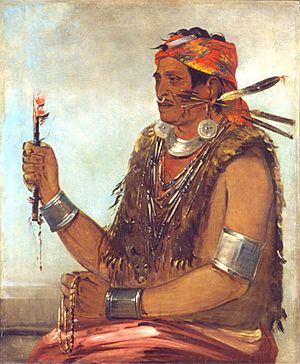
While Tecumseh lived along the White River, Native Americans faced many problems. These included sickness, poverty, and losing their land. Their traditional way of life was changing. Several religious leaders appeared, offering ways to deal with these problems. One of them was Tecumseh's younger brother, Lalawéthika. He was a healer in Tecumseh's village. Before this, Lalawéthika was not seen as very important. In 1805, he began to preach. He used ideas from earlier prophets. Lalawéthika told people to reject European influences and old traditions. Tecumseh followed his brother's teachings. He ate only Native food, wore traditional Shawnee clothes, and did not drink alcohol.
In 1806, Tecumseh and Lalawéthika, now called the Shawnee Prophet, built a new town. It was near the ruins of Fort Greenville in Ohio, where the 1795 treaty was signed. The Prophet's message spread widely. Many people from different tribes came to visit and join. The brothers hoped to bring all the scattered Shawnees together at Greenville. But they were opposed by Black Hoof, a Shawnee chief who worked with the Americans. Black Hoof and other leaders wanted Shawnees to adapt to American customs. They hoped to create a safe Shawnee homeland in northern Ohio. Most Ohio Shawnees followed Black Hoof and did not join the Prophet's movement. However, important leaders like Blue Jacket and Roundhead joined the Prophet. Roundhead became Tecumseh's close friend.
American settlers became worried as many Native Americans gathered at Greenville. In 1806 and 1807, Tecumseh and Blue Jacket went to Chillicothe, Ohio's capital. They wanted to assure the governor that Greenville was not a threat. Rumors of war between the United States and Great Britain began to spread. To avoid these tensions, Tecumseh and the Prophet decided to move west. They wanted a safer place, farther from American forts and closer to other Native allies.
In 1808, Tecumseh and the Prophet built a village that Americans called Prophetstown. It was north of Lafayette, Indiana. The Prophet took a new name, Tenskwatawa, meaning "The Open Door." This meant he was the way to salvation for his followers. Like Greenville, Prophetstown attracted many people. It included Shawnees, Potawatomis, Kickapoos, Winnebagos, Sauks, Ottawas, Wyandots, and Iowas. This was a unique mix of tribes living together. About 6,000 people settled there, making it larger than any American city in the region. Prophetstown was like its own independent city.
At first, Tecumseh and Tenskwatawa tried to live peacefully with the United States. A major change happened in September 1809. William Henry Harrison, governor of the Indiana Territory, signed the Treaty of Fort Wayne. This treaty bought about 2.5 to 3 million acres of land in Indiana and Illinois. Many Native leaders signed the treaty, but others who used the land were not included. The treaty made many Native Americans very angry. Historians say it "put Tecumseh on the road to war" with the United States.
Building a Native Alliance
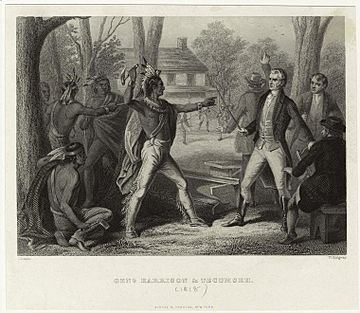
Before the Treaty of Fort Wayne, Tecumseh was not well known. People often called him "the Prophet's brother." After the treaty, he became a key figure. He worked to build an alliance of tribes to stop U.S. expansion. In August 1810, Tecumseh met with William Henry Harrison in Vincennes, the capital of Indiana Territory. This meeting became famous. Tecumseh demanded that Harrison cancel the Fort Wayne land deal. He said he would fight American settlement on the disputed lands. He also said that chiefs who signed the treaty would be punished. Tecumseh explained he was uniting the tribes to stop more land from being given away. Harrison insisted the land was bought fairly. He said Tecumseh had no right to object because Native Americans did not own land together. Harrison said he would tell President James Madison Tecumseh's demands, but he did not expect them to be accepted. As the meeting ended, Tecumseh told Harrison that if the treaty was not canceled, "you and I will have to fight it out."
After this meeting, Tecumseh traveled widely to build his alliance. He went west to recruit allies among the Potawatomis, Winnebagos, Sauks, Foxes, Kickapoos, and Missouri Shawnees. In November 1810, he visited Fort Malden in Upper Canada. He asked British officials for help in the coming war. The British were careful and urged peace. In May 1811, Tecumseh visited Ohio to recruit warriors among the Shawnees, Wyandots, and Senecas. After returning to Prophetstown, he sent a group to the Iroquois in New York.
In July 1811, Tecumseh met Harrison again in Vincennes. He told the governor he had formed an alliance of northern tribes. He was now heading south to do the same. For the next six months, Tecumseh traveled about 3,000 miles. He went south and west to find allies. He likely met with Chickasaws, Choctaws, Muscogee, Osages, western Shawnees and Delawares, Iowas, Sauks, Foxes, Sioux, Kickapoos, and Potawatomis. Two unusual events helped him: the Great Comet of 1811 and the New Madrid earthquake. He and other Native Americans saw these as signs that his alliance should be supported. Many tribes rejected his ideas, especially in the south. However, some Muscogee, known as the Red Sticks, responded to Tecumseh's call to arms. This helped lead to the Creek War.
Historians believe Tecumseh made a "serious mistake" by telling Harrison he would be away from Prophetstown for a long time. Harrison wrote that Tecumseh's absence was a "most favorable opportunity for breaking up his Confederacy." In September 1811, Harrison marched toward Prophetstown with about 1,000 men. In the early morning of November 7, warriors from Prophetstown launched a surprise attack on Harrison's camp. This started the Battle of Tippecanoe. Harrison's men held their ground. The Prophet's warriors then left Prophetstown. The Americans burned the village the next day and returned to Vincennes.
Many historians used to think the Battle of Tippecanoe was a huge defeat for Tecumseh's alliance. Some stories said Tecumseh was furious with Tenskwatawa after the battle. They said the Prophet then played a smaller role. However, newer studies question this. They suggest that stories of Tenskwatawa's disgrace came from Harrison's allies. The battle was a setback for Tenskwatawa, but he continued to be the alliance's spiritual leader. Tecumseh remained its diplomat and military leader.
Harrison hoped his attack would stop Tecumseh's alliance. Instead, violence increased after the battle. Native Americans, many who fought at Tippecanoe, sought revenge. They killed many Americans. Tecumseh tried to stop warriors from acting too soon. He prepared the alliance for future fights. By June 1812, when the United States declared war on Great Britain, about 800 warriors had gathered near the rebuilt Prophetstown. Tecumseh's Native American allies in the Northwest Territory numbered around 3,500 warriors.
Tecumseh in the War of 1812

In June 1812, Tecumseh arrived at Fort Malden in Amherstburg. He joined the British in the War of 1812. The British had few soldiers and supplies in the west. So, Native allies were very important for defending Upper Canada. The British quickly saw Tecumseh as their most important Native ally. They relied on him to lead the Native forces. He and his warriors scouted enemy positions. American General William Hull crossed into Canada and threatened Fort Malden. On July 25, Tecumseh's warriors fought with Americans north of Amherstburg. They caused the first American deaths of the war.
Tecumseh then focused on cutting off Hull's supply lines south of Detroit. On August 5, he led 25 warriors in two surprise attacks. They scattered a much larger American force. Tecumseh captured Hull's mail. It showed that the general was afraid of being cut off. On August 9, Tecumseh joined British soldiers at the Battle of Maguaga. They successfully stopped Hull from reopening his supply lines. Two days later, Hull pulled his last men from Amherstburg. This ended his attempt to invade Canada.
Siege of Detroit
On August 14, Major-General Isaac Brock, the British commander of Upper Canada, arrived at Fort Malden. He began to plan an attack on Hull at Fort Detroit. When Tecumseh heard Brock's plans, he reportedly said, "This is a man!" Tecumseh and Brock quickly became friends. This helped strengthen their alliance. Brock respected Tecumseh greatly. This led to a popular belief that Tecumseh was made a brigadier general in the British Army, but this is a myth.
Tecumseh led about 530 warriors in the Siege of Detroit. One story says Tecumseh had his men repeatedly walk through an opening in the woods. This made it seem like thousands of Native Americans were outside the fort. This story might not be true. To everyone's surprise, Hull decided to surrender on August 16.
Afterward, Brock wrote about Tecumseh: "He who caught most of my attention was a Shawnee chief, Tecumseh, brother to the Prophet. For the last two years, he has fought actively against the United States, despite our warnings. I believe a more clever or brave warrior does not exist. Everyone who spoke with him admired him."
Brock likely promised Tecumseh that the British would support Native American land claims. He wrote to his leaders that restoring land "unfairly taken" from Native Americans should be part of any peace treaty. News of Detroit's capture made the British discuss creating an Indian barrier state. This state would help protect Upper Canada. After his short stay, Brock returned to the Niagara frontier. He was killed in action there a few weeks later. Meanwhile, the British made a temporary truce and stopped further attacks. Tecumseh was frustrated by this unexpected truce. His alliance was attacking other American forts and needed British help. In September 1812, he and Roundhead led 600 warriors to help in an attack on Fort Wayne. But the attack failed before they arrived. Another attack on Fort Harrison also failed. Tecumseh stayed in the Prophetstown area for the rest of 1812. He helped organize Native American war efforts.
Fighting at Fort Meigs
Tecumseh returned to Amherstburg in April 1813. Meanwhile, the Americans, after losing at the Battle of Frenchtown in January 1813, were pushing back toward Detroit. They were led by William Henry Harrison. Tecumseh and Roundhead led about 1,200 warriors to Fort Meigs. This was a new American fort along the Maumee River in Ohio. The Native Americans saw little action at first. British forces under General Henry Procter attacked the fort. Fighting outside the fort began on May 5 when American reinforcements arrived. They attacked the British gun positions. Tecumseh led an attack on an American group leaving the fort. Then he crossed the river to help defeat a group of Kentucky militia. The British and Native Americans caused many casualties among the Americans outside the fort. But they failed to capture it. Procter's Canadian militia and many of Tecumseh's warriors left after the battle. So, Procter had to end the attack.
One of the most famous events in Tecumseh's life happened after this battle. American prisoners were taken to the nearby ruins of Fort Miami. When some Native Americans began killing prisoners, Tecumseh quickly stopped the slaughter. Historians say Tecumseh's protection of the American prisoners became a key part of his legend. It showed his great character. Some stories say Tecumseh criticized General Procter for not protecting the prisoners, though this might not be true.
Tecumseh and Procter returned to Fort Meigs in July 1813. Tecumseh had 2,501 warriors with him, the largest group he ever led. They had little hope of taking the strong fort. But Tecumseh wanted to draw the Americans into an open battle. He staged a fake battle near the fort, hoping the Americans would come out to help. The trick failed, and the second attack on Fort Meigs was called off. Procter then led a group to attack Fort Stephenson on the Sandusky River. Tecumseh went west to stop any American advances. Procter's attack failed, and the group returned to Amherstburg.
Tecumseh's Death

Tecumseh hoped for more attacks. But after the American naval victory in the Battle of Lake Erie on September 10, 1813, Procter decided to retreat from Amherstburg. Tecumseh begged Procter to stay and fight: "Our lives are in the hands of the Great Spirit. We are determined to defend our lands, and if it is his will, we wish to leave our bones upon them." Procter insisted that defending Amherstburg was impossible now that Americans controlled Lake Erie. But he promised to make a stand at Chatham, along the Thames River. Tecumseh reluctantly agreed. The British burned Fort Malden and other buildings in Amherstburg. Then they began to retreat, with William Henry Harrison's army chasing them.
Tecumseh arrived at Chatham to find that Procter had retreated even further upriver. Procter sent word that he had chosen to make a stand near Moraviantown. Tecumseh was angry about the change in plans. But he led a small fight at Chatham to slow the American advance. He was slightly wounded in the arm. Many of Tecumseh's discouraged allies left during the retreat. This left him with only 500 warriors. Procter and Tecumseh, outnumbered more than three to one, faced the Americans at the Battle of the Thames on October 5. Tecumseh placed his men in a line of trees on the right, hoping to attack the Americans from the side. The left side, led by Procter, quickly collapsed, and Procter fled the battlefield. Colonel Richard Mentor Johnson led the American charge against the Native Americans. Tecumseh was killed in the fierce fighting, and the Native Americans scattered. The Americans won a clear victory.
The exact location of Tecumseh's body is unknown. Early stories said his body was taken by Canadians and buried at Sandwich. Later stories said he was buried at the battlefield, or secretly moved elsewhere. Another tradition says an Ojibwe named Oshahwahnoo, who fought at Moraviantown, dug up Tecumseh's body in the 1860s. He then buried it on St. Anne Island on the St. Clair River. In 1931, these bones were examined. Tecumseh had broken a thighbone in a riding accident as a youth and walked with a limp. But neither thigh of this skeleton was broken. Still, in 1941, the remains were buried on nearby Walpole Island in a ceremony honoring Tecumseh. A book by St-Denis (2005) concluded that Tecumseh was likely buried on the battlefield and his remains are now lost.
At first, published accounts said Richard Mentor Johnson killed Tecumseh. In 1816, another account claimed a different soldier fired the fatal shot. This became a debate in the 1830s when Johnson was running for Vice President of the United States. Johnson's supporters promoted him as Tecumseh's killer. Johnson's opponents gathered stories that disagreed with this claim. Many other people were named as possibilities. Historians like Sugden (1985) say Johnson's claim is the strongest, but not certain. Johnson became Vice President in 1837, largely famous for claiming to have killed Tecumseh.
Tecumseh's death caused his alliance to fall apart. Most of his followers did little more fighting, except in the southern Creek War. In the talks that ended the War of 1812, the British tried to keep promises made to Tecumseh. They insisted on creating a Native American barrier state in the Old Northwest. The Americans refused, and the idea was dropped. The Treaty of Ghent (1814) said Native American lands should return to their 1811 borders. But the United States had no intention of doing this. By the late 1830s, the U.S. government forced Shawnees still living in Ohio to sign removal treaties. They had to move west of the Mississippi River.
Tecumseh's Legacy
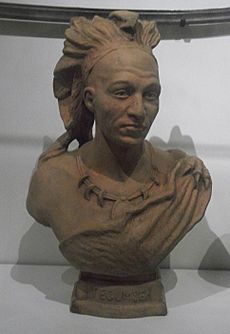
Tecumseh was widely admired during his lifetime, even by Americans who fought him. His main American enemy, William Henry Harrison, called Tecumseh "one of those rare geniuses, who appear sometimes to cause revolutions and change the established order of things." After his death, he became a famous folk hero in American, Indigenous, and Canadian history. For many Native Americans in the United States and First Nations people in Canada, he became a hero who goes beyond tribal identity. Tecumseh's importance grew over the years after his death. This often happened at the expense of Tenskwatawa, whose religious beliefs white writers found strange. White writers often made Tecumseh seem like a "secular" leader who only used his brother's religious movement for political reasons. For many Europeans and white North Americans, he became the best example of the "noble savage" idea.
Tecumseh is honored in Canada as a hero. He played a major role in Canada's defense in the War of 1812. He is remembered alongside Sir Isaac Brock and Laura Secord. John Richardson, an early Canadian novelist, served with Tecumseh and admired him greatly. His 1828 poem "Tecumseh; or, The Warrior of the West" aimed to "keep the memory of one of the noblest and most gallant spirits" in history. Canadian writers like Charles Mair (Tecumseh: A Drama, 1886) celebrated Tecumseh as a Canadian patriot. This idea is seen in many biographies written for Canadian schoolchildren. However, portraying Tecumseh as a Canadian patriot has been criticized. It hides his true goal of protecting Native homelands outside of Canada. Many things in Canada are named after Tecumseh. These include the naval reserve unit HMCS Tecumseh and Tecumseh, Ontario. In 1931, the Canadian government named Tecumseh a person of national historic significance.
Tecumseh has long been admired in Germany. This is especially due to popular novels by Fritz Steuben, starting with The Flying Arrow (1930). Steuben used Tecumseh to promote Nazi ideas, though later versions of his novels removed these parts. An East German film, Tecumseh, was released in 1972.
In the United States, Tecumseh became a legendary figure. The true details of his life are often mixed with myths. According to Edmunds (2007), "the real Tecumseh has been overshadowed by a folk hero whose adventures combine the best of fact and fiction." Only in the late 20th century did historians begin to separate fact from fiction. The fictional Tecumseh has appeared in many poems, plays, and novels. He has also been in several movies and outdoor dramas. Examples include George Jones's Tecumseh; or, The Prophet of the West (1844 play), Mary Catherine Crowley's Love Thrives in War (1903 novel), Brave Warrior (1952 film), and Allan W. Eckert's A Sorrow in Our Hearts: The Life of Tecumseh (1992 novel). James Alexander Thom's 1989 novel Panther in the Sky was made into a TV movie, Tecumseh: The Last Warrior (1995). The outdoor drama Tecumseh! has been performed near Chillicothe, Ohio, since 1973. Written by Allan Eckert, the story includes a fictional romance between Tecumseh and a white settler woman. This is an example of the "vanishing Indian" idea popular with white Americans.
See also
 In Spanish: Tecumseh para niños
In Spanish: Tecumseh para niños


